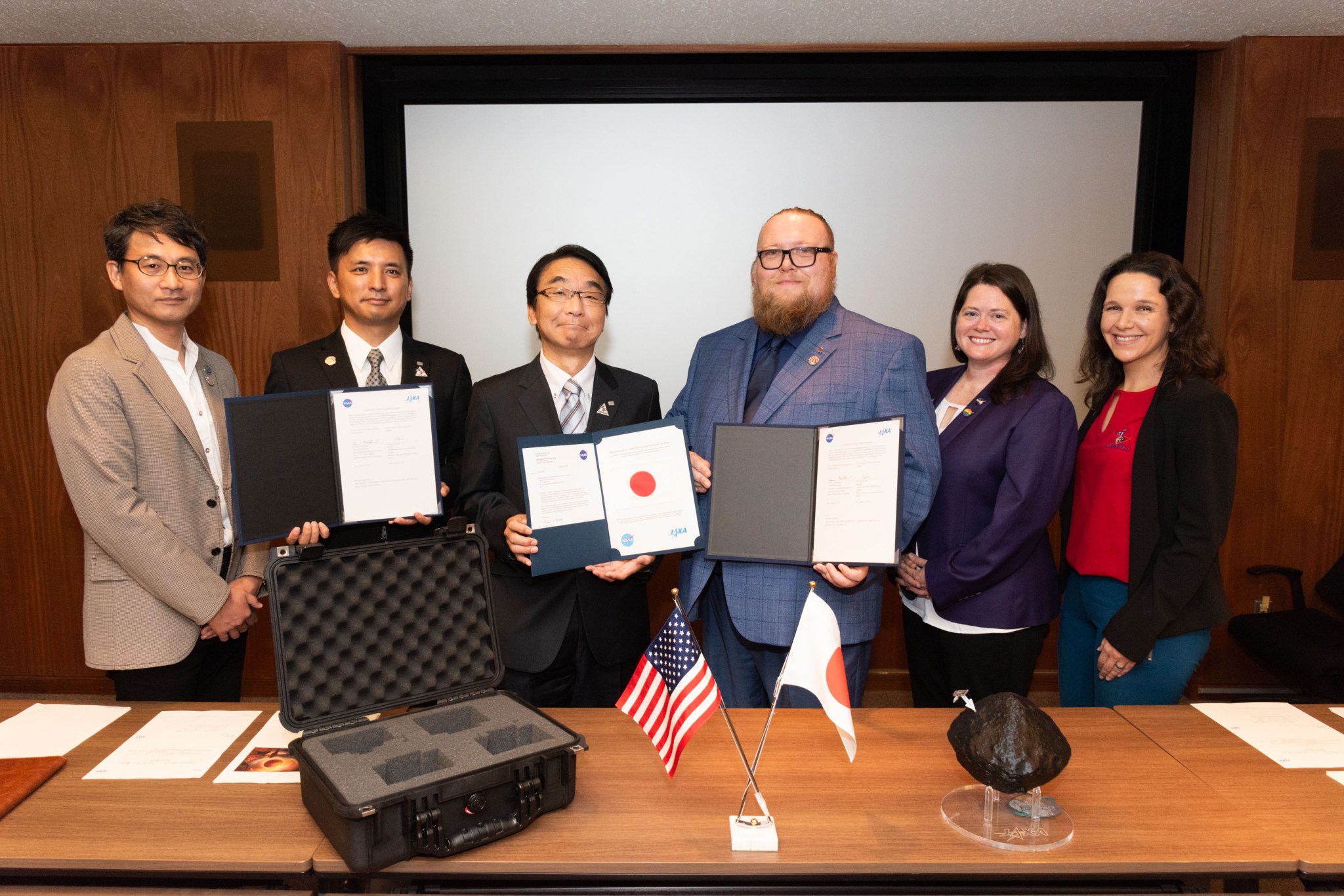
As part of an asteroid sample exchange, NASA has transferred to JAXA (Japan Aerospace Exploration Agency) a portion of the asteroid Bennu sample collected by the agency’s OSIRIS-REx mission. The sample was officially handed over by NASA officials during a ceremony on Aug. 22 at JAXA’s Sagamihara, Japan, campus.
This asteroid sample transfer follows the November 2021 exchange where JAXA transferred to NASA a portion of the sample retrieved from asteroid Ryugu by its Hayabusa2 spacecraft. This agreement allows NASA and JAXA to share achievements and promote scientific and technological cooperation on asteroid sample return missions. The scientific goals of the two missions are to understand the origins and histories of primitive, organic-rich asteroids and what role they may have played in the formation of the planets.
“We value our continued collaboration with JAXA on asteroid sample return missions to both increase our science return and reduce risk on these and other missions,” said Kathleen Vander Kaaden, chief scientist for astromaterials curation in the Science Mission Directorate at NASA Headquarters in Washington. “JAXA has extensive curation capabilities, and we look forward to what we will learn from the shared analysis of the OSIRIS-REx samples.”
The Origins, Spectral Interpretation, Resource Identification, and Security-Regolith Explorer, or OSIRIS-REx, spacecraft delivered 4.29 ounces (121.6 grams) of material from Bennu, more than double the mission’s mass requirement, as well as 24 steel Velcro® pads containing dust from the contact with Bennu. As part of the agreement, the Astromaterials Research and Exploration Science Division at NASA’s Johnson Space Center in Houston transferred to JAXA 0.023 ounces (0.66 grams) of the Bennu sample, equaling 0.55% of the total sample mass, and one of the 24 contact pads.
Hayabusa2 collected 0.19 ounces (5.4 grams) of Ryugu between two samples and, in 2021, JAXA provided NASA with 23 millimeter-sized grains plus aggregate sample material from Ryugu, enabling both countries to get the most out of the samples and share the responsibility of sample curation.
JAXA’s portion of the Bennu samples will be housed in the newly expanded clean rooms in the extraterrestrial sample curation center on the JAXA Sagamihara campus. The JAXA team received the samples enclosed in non-reactive nitrogen gas and will open them in similarly nitrogen-filled clean chambers, accessed with air-tight gloves. JAXA will now work to create an initial description of the sample, including weight measurements, imaging with both visible light and infrared light microscopes, and infrared spectroscopy. The sample will then be distributed through a competitively selected process for detailed analysis at other research institutes to study the differences and similarities between asteroids Bennu and Ryugu.
“Thank you for safely bringing the precious asteroid samples from Bennu to Earth and then to Japan,” said Tomohiro Usui, Astromaterials Science Research Group Manager, Institute of Space and Astronautical Science, JAXA. “As fellow curators, we understand the tension and responsibility that accompany these tasks. Now, it is our turn at JAXA. We will go ahead with our plans to derive significant scientific outcomes from these valuable samples.”
Asteroids are debris left over from the dawn of the solar system. The Sun and its planets formed from a cloud of dust and gas about 4.6 billion years ago, and asteroids are thought to date back to the first few million years of our solar system’s history. Sample return missions like OSIRIS-REx and Hayabusa2 help provide new data on how the solar system’s evolution unfolded.
Initial analysis of the Bennu samples has revealed dust rich in carbon and nitrogen. Members of the OSIRIS-REx sample analysis team have also found evidence of organic molecules and minerals bearing phosphorous and water, which together could indicate the building blocks essential for life.
Both the Bennu sample and the asteroid Ryugu sample delivered by JAXA’s Hayabusa2 mission appear to have come from an ancient parent object formed beyond the current orbit of Saturn that was broken up and transported into the inner solar system. The differences between these asteroids are emerging as the detailed chemistry is analyzed.
NASA’s Goddard Space Flight Center in Greenbelt, Maryland, provided overall mission management, systems engineering, and the safety and mission assurance for OSIRIS-REx. Dante Lauretta of the University of Arizona, Tucson, is the principal investigator. The university leads the science team and the mission’s science observation planning and data processing. Lockheed Martin Space in Littleton, Colorado, built the spacecraft and provided flight operations. Goddard and KinetX Aerospace were responsible for navigating the OSIRIS-REx spacecraft. Curation for OSIRIS-REx takes place at NASA Johnson. International partnerships on this mission include the OSIRIS-REx Laser Altimeter instrument from CSA (Canadian Space Agency) and asteroid sample science collaboration with JAXA’s Hayabusa2 mission. OSIRIS-REx is the third mission in NASA’s New Frontiers Program, managed by NASA’s Marshall Space Flight Center in Huntsville, Alabama, for the agency’s Science Mission Directorate in Washington.
Find more information about NASA’s OSIRIS-REx mission at:
https://science.nasa.gov/mission/osiris-rex
-end-
News Media Contacts
Wynn Scott
NASA’s Johnson Space Center, Houston
281-910-6835
[email protected]
Karen Fox / Alana Johnson
NASA Headquarters, Washington
202-358-1600
[email protected] / [email protected]










